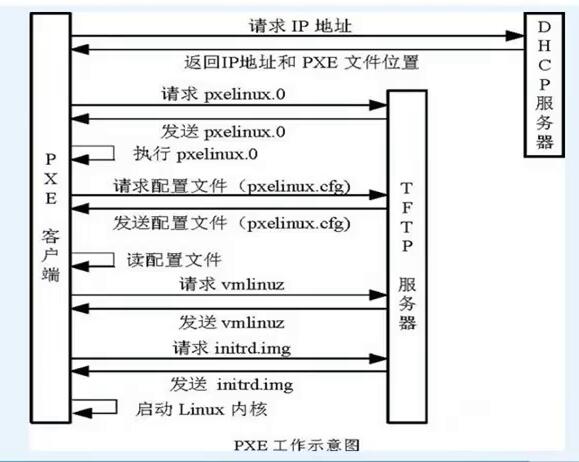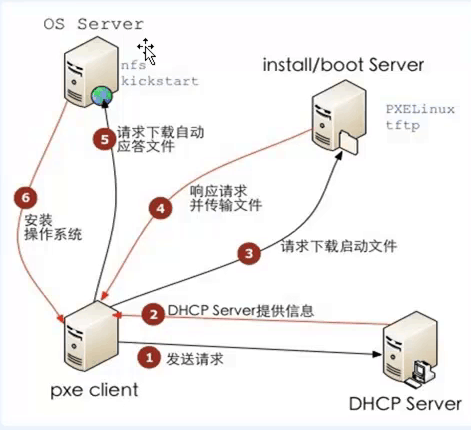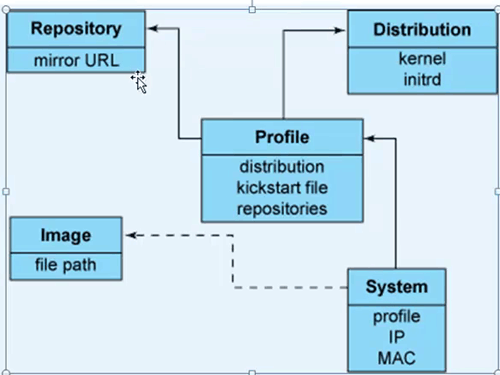1. 自动化运维系列之Cobbler自动装机
preface
我们之前批量安装操作系统的时候都是采用pxe来安装,pxe也是通过网络安装操作系统的,但是PXE依赖于DHCP,HTTP/TFTP,kicstart等支持。安装流程如下所示:


对于上面的PXE安装流程,我们需要知道我们做了以下的工作:
- 配置服务,如DHCP、TFTP、(HTTP、FTP、和NFS)
- 在dhcp和TFTP配置文件中填入客户端机器的信息。
- 创建自动部署文件(比如kickstart)
- 将安装的媒介解压缩到HTTP/FTP/NFS存储库中。
PXE装机也是一个不错的选择对于批量装机的话,现在呢我们学习另一种安装操作系统的软件cobbler。它具有以下功能:
- 使用一个以前定义的模版来配置DHCP服务(如果启用了管理DHCP)
- 将一个存储库(yum或rsync)建立镜像或者解压缩一个媒介,以注册一个新的操作系统。
- 在DHCP配置文件中为需要安装的机器创建一个条目并使用我们指定的参数(IP、mac地址)
- 在TFTP服务目录下创建适当的PXE文件
- 重新启动DHCP服务以反映更改
- 重新启动机器以开始安装(如果电源管理已经启用的话。)
cobbler简介:

- Disribution : 发行内核,initrd等东西
- Repository: 创建仓库,比如yum仓库等。
- system: 通过mac地址来定制化系统
- profile: 对需要安装某个系统的所有配置。
基础环境介绍
首先我先说说的环境吧
| IP地址 | 主机名 |
|---|---|
| 192.168.56.11 | linux-node1.example.com |
- 内核为3.10.0-514.2.2.el7.x86_64
- 网卡名字设置为了eth0。
- 关闭了selinux,iptables。
- 时间同步ntp.chinacache.com
- hosts文件里面需要写下hostname,便于解析。
开始安装cobbler
我们采用yum安装的方式来安装:
1.安装cobbler以及相关的软件
[root@linux-node1 ~]# yum -y install httpd dhcp tftp python-ctypes cobbler xinetd
2.启动服务(先起服务是因为这样才知道我们没有配置哪些东东)
[root@linux-node1 ~]# systemctl start httpd
[root@linux-node1 ~]# systemctl enable httpd
[root@linux-node1 ~]# systemct1 enable cobblerd
[root@linux-node1 ~]# systemctl start cobblerd
3.看看哪些配置文件没有改,下面的工作就是要处理掉这些提示信息。这样cobbler就能够正常工作了。
[root@linux-node1 ~]# cobbler check
The following are potential configuration items that you may want to fix:
1 : The 'server' field in /etc/cobbler/settings must be set to something other than localhost, or kickstarting features will not work. This should be a resolvable hostname or IP for the boot server as reachable by all machines that will use it.
# 设置PXE文件
2 : For PXE to be functional, the 'next_server' field in /etc/cobbler/settings must be set to something other than 127.0.0.1, and should match the IP of the boot server on the PXE network.
# 设置tftp
3 : change 'disable' to 'no' in /etc/xinetd.d/tftp
# 把网络的boot-loaders通过cobbler get-loaders后放在/var/lib/cobbler/loaders
4 : some network boot-loaders are missing from /var/lib/cobbler/loaders, you may run 'cobbler get-loaders' to download them, or, if you only want to handle x86/x86_64 netbooting, you may ensure that you have installed a *recent* version of the syslinux package installed and can ignore this message entirely. Files in this directory, should you want to support all architectures, should include pxelinux.0, menu.c32, elilo.efi, and yaboot. The 'cobbler get-loaders' command is the easiest way to resolve these requirements.
# 启动rsync服务
5 : enable and start rsyncd.service with systemctl
6 : debmirror package is not installed, it will be required to manage debian deployments and repositories
# 生成一个默认的密码对于新安装的设备
7 : The default password used by the sample templates for newly installed machines (default_password_crypted in /etc/cobbler/settings) is still set to 'cobbler' and should be changed, try: "openssl passwd -1 -salt 'random-phrase-here' 'your-password-here'" to generate new one
#
8 : fencing tools were not found, and are required to use the (optional) power management features. install cman or fence-agents to use them
Restart cobblerd and then run 'cobbler sync' to apply changes.
4.修改配置文件
[root@linux-node1 ~]# vim /etc/cobbler/settings
server: 192.168.56.11 # 把这些地址都改为本机的IP
next_server: 192.168.56.11
5.再次检测配置文件,显然这提示的数量下降到了5,我们在逐个击破。
[root@linux-node1 ~]# cobbler check #
The following are potential configuration items that you may want to fix:
1 : change 'disable' to 'no' in /etc/xinetd.d/tftp
2 : enable and start rsyncd.service with systemctl
3 : debmirror package is not installed, it will be required to manage debian deployments and repositories
4 : The default password used by the sample templates for newly installed machines (default_password_crypted in /etc/cobbler/settings) is still set to 'cobbler' and should be changed, try: "openssl passwd -1 -salt 'random-phrase-here' 'your-password-here'" to generate new one
5 : fencing tools were not found, and are required to use the (optional) power management features. install cman or fence-agents to use them
6.修改xinetd的配置文件以及启动和启动rsync
[root@linux-node1 ~]# vim /etc/xinetd.d/tftp
disable : no
[root@linux-node1 ~]# systemctl start rsyncd
[root@linux-node1 ~]# systemctl enable rsyncd.service
[root@linux-node1 ~]# systemctl restart xinetd
7.配置cobbler的密码
[root@linux-node1 ~]# openssl passwd -1 -salt '123123' '123123'
$1$123123$MAV.kVI/b3swmFLErPD2b0
[root@linux-node1 ~]# vim /etc/cobbler/settings
default_password_crypted: "$1$123123$MAV.kVI/b3swmFLErPD2b0"
为什么我们这样设置密码呢?因为我们看cobbler这样提示的:try: "openssl passwd -1 -salt 'random-phrase-here' 'your-password-here'" to generate new one,所以我们使用这个命令来做。
8.下载loader
[root@cobbler ~]# cobbler get-loaders
9.最后查看cobbler check
[root@linux-node1 ~]# cobbler check
The following are potential configuration items that you may want to fix:
1 : debmirror package is not installed, it will be required to manage debian deployments and repositories
2 : fencing tools were not found, and are required to use the (optional) power management features. install cman or fence-agents to use them
Restart cobblerd and then run 'cobbler sync' to apply changes.
我们可以看到还有2条提示信息,我们可以暂且忽略他们。不需要关注。
配置cobbler-DHCP
我们配置cobbler的DHCP,使其cobbler来控制dhcp服务在进行装机的时候。
1.修改cobbler配置:
[root@linux-node1 cobbler]# vim /etc/cobbler/settings
manage_dhcp: 1 # set to 1 to enable Cobbler's DHCP management features.
2.修改dhcp.templates配置文件
[root@linux-node1 ~]# cd /etc/cobbler/
[root@linux-node1 cobbler]# vim dhcp.template # 主要是修改了下面几项
subnet 192.168.56.0 netmask 255.255.255.0 { # 子网
option routers 192.168.56.2; # 网关
option domain-name-servers 192.168.56.2; # dns-server
option subnet-mask 255.255.255.0; # 子网掩码
range dynamic-bootp 192.168.56.100 192.168.56.254; # 地址池
3.重启服务并同步配置,改完dhcp必须要sync同步配置。
[root@linux-node1 cobbler]# systemctl restart cobblerd
[root@linux-node1 cobbler]# cobbler sync
task started: 2017-02-25_051458_sync
task started (id=Sync, time=Sat Feb 25 05:14:58 2017)
...省略N行提示
generating /etc/dhcp/dhcpd.conf # 注意这个dhcp,会自动生成我们刚才的配置。
*** TASK COMPLETE ***
4.检测dhcp端口
[root@linux-node1 cobbler]# netstat -lnup |grep dhcp
udp 0 0 0.0.0.0:67 0.0.0.0:* 31034/dhcpd
udp 0 0 0.0.0.0:55385 0.0.0.0:* 31034/dhcpd
udp6 0 0 :::35318 :::* 31034/dhcpd
导入CentOs-7的镜像
我们先上传一个镜像到linux-node1.example.com上。然后开始导入:
[root@linux-node1 cobbler]# mount -o loop /opt/CentOS-7.0-1406-x86_64-DVD.iso /mnt/
mount: /dev/loop0 is write-protected, mounting read-only
[root@linux-node1 cobbler]# cobbler import --path=/mnt --name=CentOS-7.0-1406-x86_64 --arch=x86_64
导入时间有点长,稍等下。
导入的文件是放在这里/var/www/cobbler/ks_mirror的:
[root@linux-node1 ks_mirror]# pwd
/var/www/cobbler/ks_mirror
[root@linux-node1 ks_mirror]# ls
CentOS-7.0-1406-x86_64 config
之所以导入到这里,是因为apache的配置文件,详情可看/etc/httpd/conf.d/cobbler.conf.
导入完镜像以后,那么就使查看下cobbler
[root@linux-node1 cobbler]# cobbler list
distros:
CentOS-7.0-1406-x86_64
profiles:
CentOS-7.0-1406-x86_64
systems:
repos:
images:
mgmtclasses:
packages:
files:
导入kickstarts配置文件
上面有了镜像,那么下一步我们就需要导入kickstarts了。
[root@linux-node1 kickstarts]# pwd
/var/lib/cobbler/kickstarts
[root@linux-node1 kickstarts]# ll -rt
total 52
-rw-r--r-- 1 root root 5879 Nov 16 11:09 sample.seed
-rw-r--r-- 1 root root 3419 Nov 16 11:09 sample_old.seed
-rw-r--r-- 1 root root 1784 Nov 16 11:09 sample.ks
-rw-r--r-- 1 root root 386 Nov 16 11:09 sample_esxi5.ks
-rw-r--r-- 1 root root 324 Nov 16 11:09 sample_esxi4.ks
-rw-r--r-- 1 root root 0 Nov 16 11:09 sample_esx4.ks
-rw-r--r-- 1 root root 1825 Nov 16 11:09 sample_end.ks
-rw-r--r-- 1 root root 2916 Nov 16 11:09 sample_autoyast.xml
-rw-r--r-- 1 root root 292 Nov 16 11:09 pxerescue.ks
-rw-r--r-- 1 root root 1424 Nov 16 11:09 legacy.ks
-rw-r--r-- 1 root root 22 Nov 16 11:09 esxi5-ks.cfg
-rw-r--r-- 1 root root 22 Nov 16 11:09 esxi4-ks.cfg
-rw-r--r-- 1 root root 115 Nov 16 11:09 default.ks
drwxr-xr-x 2 root root 54 Feb 25 04:09 install_profiles
到了这一步,我把自己写的kickstart文件给上传上去,然后执行下面命令导入刚才的:
[root@linux-node1 kickstarts]# cobbler profile report
[root@linux-node1 kickstarts]# cobbler profile list
CentOS-7.0-1406-x86_64
[root@linux-node1 kickstarts]# cobbler profile edit --name CentOS-7.0-1406-x86_64 --kickstart=/var/lib/cobbler/kickstarts/CentOS-7.1-x86_64_cobbler.cfg #这里写我们刚才上传的配置文件。
[root@linux-node1 kickstarts]# cobbler profile edit --name CentOS-7.0-1406-x86_64 --kopts='net.ifnames=0 biosdevname=0' # 添加内核参数在grub配置文件里面,换句话说就是系统启动的时候。
[root@linux-node1 kickstarts]# cobbler profile report # 再次执行这个,看有没有修改成功
我的kickstart文件内容如下:
#platform=x86, AMD64, or Intel EM64T
#System language
lang en_US
#System keyboard
keyboard us
#Sytem timezone
timezone Asia/Shanghai
#Root password
rootpw --iscrypted $default_password_crypted
#rootpw --iscrypted $1$ops-node$7hqdpgEmIE7Z0RbtQkxW20
#Use text mode install
text
#Install OS instead of upgrade
install
#Use NFS installation Media
url --url=$tree
#url --url=http://192.168.56.11/CentOS-7.1-x86_64
#System bootloader configuration
bootloader --location=mbr
#Clear the Master Boot Record
zerombr
#Partition clearing information
clearpart --all --initlabel
#Disk partitioning information
part /boot --fstype xfs --size 1024 --ondisk sda
part swap --size 1024 --ondisk sda
part / --fstype xfs --size 1 --grow --ondisk sda
#System authorization infomation
auth --useshadow --enablemd5
#Network information
$SNIPPET('network_config')
#network --bootproto=dhcp --device=eth0 --onboot=on
# Reboot after installation
reboot
#Firewall configuration
firewall --disabled
#SELinux configuration
selinux --disabled
#Do not configure XWindows
skipx
#Package install information
%pre
$SNIPPET('log_ks_pre')
$SNIPPET('kickstart_start')
$SNIPPET('pre_install_network_config')
# Enable installation monitoring
$SNIPPET('pre_anamon')
%end
%packages
@ base
@ core
sysstat
iptraf
ntp
lrzsz
ncurses-devel
openssl-devel
zlib-devel
OpenIPMI-tools
mysql
nmap
screen
%end
%post
systemctl disable postfix.service
# Start yum configuration
$yum_config_stanza
# End yum configuration
rpm -ihv https://mirrors.aliyun.com/epel/epel-release-latest-7.noarch.rpm
%end
最后一步同步数据:
[root@linux-node1 kickstarts]# cobbler sync
安装CentOs-7操作系统。
- 此时Cobbler已经能够安装操作系统了,下一步我们就创建一台虚拟机来安装操作系统吧。
- 我们使用vmware来创建一个虚拟机,同时调整vmware的网络参数,关闭vmware的DHCP功能,同事确保新创建的虚拟机和cobbler主机在同一网段。
- 启动刚才新创建的虚拟机,选择网络安装操作系统就可以了。
附加功能
1.修改安装界面的标题
我们可以自定义安装的tittle,如下所示:
[root@linux-node1 pxe]# vim /etc/cobbler/pxe/pxedefault.template
MENU TITLE | http://cobbler.github.io/ # 自定义标题。
TIMEOUT 200 # 超时时间20S,单位为毫秒
2.使用cobbler-web功能
我们安装下cobbler-web功能
[root@linux-node1 pxe]# yum -y install cobbler-web
[root@linux-node1 pxe]#systemctl restart httpd.service # 重启下apache即可,因为配置文件有变动
然后访问登陆即可:
https://192.168.56.11/cobbler_web/,默认用户名密码是cobbler/cobbler
登陆的用户名密码在这里存放着:
[root@linux-node1 pxe]# tail /etc/cobbler/users.conf # 存放用户名权限的
[admins]
admin = ""
cobbler = ""
[root@linux-node1 pxe]# tail /etc/cobbler/users.digest # 存放密码的
cobbler:Cobbler:a2d6bae81669d707b72c0bd9806e01f3
看了 上面的用户名密码的存放文件后,那么下面我们修改下他的密码,使用下面的命令:
[root@linux-node1 pxe]# htdigest /etc/cobbler/users.digest "Cobbler" cobbler #连续输入2次密码即可。
我这里输入的密码是123456
3.使用koan实现重新安装系统
koan是安装在某一个需要重新安装系统的服务器上,比如我s1服务需要重新安装系统,不可能说人去一趟机房安装吧,而采用cobbler安装的话,在重启的时候需要人工选择安装哪个系统,不然默认从local启动。那怎么办呢?koan这个软件就能够很好的解决这个问题。
我们先下载阿里云的repo:https://mirrors.aliyun.com/repo/,到这里下载一个合适的yum源,我这里的下载的是CentOs7的。然后开始安装koan。
[root@localhost yum.repos.d]# yum -y install koan
安装好以后,我们可以查看cobbler-server上有哪些系统提供了。
[root@localhost yum.repos.d]# koan --server=192.168.56.11 --list=profiles
- looking for Cobbler at http://192.168.56.11:80/cobbler_api
CentOS-7.0-1406-x86_64 # 罗列出来的系统
选择重装的系统:
[root@localhost yum.repos.d]# koan --replace-self --server=192.168.56.11 --profile=CentOS-7.0-1406-x86_64
[root@localhost grub2]# less /boot/grub2/grub.cfg # 我们可以查看这个启动项里面,发现多了一些内容,这就是为啥开机后能够自动选择网络安装,是因为grub启动项里设置了。
重启系统就可以安装了。在重启的时候,我们可以看到这新添加的一个启动项,且默认是走它:

4. 创建yum仓库
cobbler不但可以装机,还可以自建yum仓库,这个仓库可以从公网的yum源进行同步到公司内网,节省带宽。同步命令如下所示:
cobbler repo add --name=CentOS-7-x86_64-epel --mirro=https://mirrors.aliyun.com/epel/7Server/x86_64/ --arch=x86_64 --breed=yum
cobbler repo add --name=openstack-newton --mirror=https://mirrors.aliyun.com/centos/7.3.1611/cloud/x86_64/openstack-newton/ --arch=x86_64 --breed=yum
cobbler reposync --tries=3 --no-fail
参数解释下:
- repo add : 添加一个repo源
- name : 为这个yum源命名
- mirror : 指定一个源的地址。
- arch : 指定平台
- breed: 类型为yum
5. 通过mac地址来定制化、自动化系统
在这一步,我们需要提前知道需要装机服务器的MAC地址,一般情况下,服务器供应商会提供了每个网卡的MAC地址,所以我们可以根据不同的MAC地址来给安装 不同的操作系统,配置不同的静态iP,设置不同的主机名等等。命令如下:
cobbler system add --name=linux-node3 --mac=00:50:56:24:82:3A \
--profile=CentOS-7.0-1406-x86_64 \
--ip-address=192.168.56.100 --subnet=255.255.255.0 \
--gateway=192.168.56.2 --interface=eth0 \
--static=1 --hostname=linux-node3.example.com \
--name-servers="192.168.56.2" \
--kickstart=/var/lib/cobbler/kickstarts/CentOS-7.1-x86_64_cobbler.cfg
参数解释下:
- system add 添加一个系统定制
- name 定义这个新添加的系统定制的名字
- mac 指定MAC
- profile 指定profile,通过
cobbler profile list查看 - ip-address 指定静态IP
- subnet 指定子网掩码
- gateway 指定网关
- interface 指定网卡
- static=1 设置为静态IP
- hostname 这是主机名
- name-servers 设置dns服务器
- kickstart 设置kickstart,通过
cobbler profile report来查看。
[root@linux-node1 ~]# cobbler system list # 创建成功后能够看到刚才新建的系统模版
linux-node3
我们创建一个虚拟机,mac地址为00:50:56:24:82:3A,启动后你就会发现自动进入安装系统了,等安装完以后,所有的配置都和我们当初设置的一样。
6. cobbler-api
cobbler也是通过restful-api来调用对应的接口,下面请看两个小脚本:
都是采用opython2.7版本运行的
[root@linux-node1 ~]# cat cobbler_list.py
#!/usr/bin/python
import xmlrpclib
server = xmlrpclib.Server("http://192.168.56.11/cobbler_api")
print server.get_distros()
print server.get_profiles()
print server.get_systems()
print server.get_images()
print server.get_repos()
下面看看创建system模版的:
[root@linux-node1 ~]# cat cobbler-api.py
#!/usr/bin/env python
# -*- coding: utf-8 -*-
import xmlrpclib
class CobblerAPI(object):
def __init__(self,url,user,password):
self.cobbler_user= user
self.cobbler_pass = password
self.cobbler_url = url
def add_system(self,hostname,ip_add,mac_add,profile):
'''
Add Cobbler System Infomation
'''
ret = {
"result": True,
"comment": [],
}
#get token
remote = xmlrpclib.Server(self.cobbler_url)
token = remote.login(self.cobbler_user,self.cobbler_pass)
#add system
system_id = remote.new_system(token)
remote.modify_system(system_id,"name",hostname,token)
remote.modify_system(system_id,"hostname",hostname,token)
remote.modify_system(system_id,'modify_interface', {
"macaddress-eth0" : mac_add,
"ipaddress-eth0" : ip_add,
"dnsname-eth0" : hostname,
}, token)
remote.modify_system(system_id,"profile",profile,token)
remote.save_system(system_id, token)
try:
remote.sync(token)
except Exception as e:
ret['result'] = False
ret['comment'].append(str(e))
return ret
def main():
cobbler = CobblerAPI("http://192.168.56.11/cobbler_api","cobbler","123456")
ret = cobbler.add_system(hostname='cobbler-api-test',ip_add='192.168.56.101',mac_add='00:50:56:21:65:78',profile='CentOS-7.0-1406-x86_64')
print ret
if __name__ == '__main__':
main()
通过这样api的方式,也能够创建system模版实现安装主机的功能。
1. 自动化运维系列之Cobbler自动装机的更多相关文章
- 2. 自动化运维系列之Cobbler给Openstack节点安装操作系统。
preface 我们在一篇博文知道了如何搭建Cobbler,那么下面就通过Cobbler来安抓Openstack所有节点吧. 服务器配置信息如下: 主机名 IP 角色 Cobbler.node.com ...
- 【转载】自动化运维系列之Cobbler给Openstack节点安装操作系统
preface 我们在一篇博文知道了如何搭建Cobbler,那么下面就通过Cobbler来安抓Openstack所有节点吧. 服务器配置信息如下: 主机名 IP 角色 Cobbler.node.com ...
- saltstack自动化运维系列11基于etcd的saltstack的自动化扩容
saltstack自动化运维系列11基于etcd的saltstack的自动化扩容 自动化运维-基于etcd加saltstack的自动化扩容# tar -xf etcd-v2.2.1-linux-amd ...
- SQL SERVER自动化运维系列
SQL SERVER自动化运维系列 转自:https://www.cnblogs.com/zhijianliutang/p/5001142.html 本系列为SQL SERVER自动化运维的一些操作技 ...
- saltstack自动化运维系列⑩SaltStack二次开发初探
saltstack自动化运维系列⑩SaltStack二次开发初探 1.当salt运行在公网或者网络环境较差的条件下,需要配置timeout时间vim /etc/salt/master timeout: ...
- saltstack自动化运维系列⑧SaltStack实践配置管理安装nginx-1.10.3
saltstack自动化运维系列⑧SaltStack实践配置管理安装nginx-1.10.3 安装nginx-1.10.3.tar.gz # mkdir -p /srv/salt/prod/pkg / ...
- saltstack自动化运维系列⑦SaltStack实践配置管理安装zabbix
saltstack自动化运维系列⑥SaltStack实践配置管理安装zabbix 1.添加管理zabbix的sls文件# vim /srv/salt/base/init/zabbix_agent.sl ...
- saltstack自动化运维系列⑥SaltStack实践安装配置HAproxy的Keepalived
saltstack自动化运维系列⑥SaltStack实践安装配置HAproxy的Keepalived 安装配置Keepalived 1.编写功能模块 #创建keepalived目录# mkdir -p ...
- saltstack自动化运维系列⑥SaltStack实践安装配置HAproxy
saltstack自动化运维系列⑥SaltStack实践安装配置HAproxy 下载haproxy1.6.2.tar.gz下载地址:http://www.haproxy.org/download/1. ...
随机推荐
- OAuth2.0 授权的工作原理
作者:Barret李靖链接:https://www.zhihu.com/question/19781476/answer/81020455来源:知乎著作权归作者所有.商业转载请联系作者获得授权,非商业 ...
- [uboot]uboot中显示logo
http://blog.chinaunix.net/uid-20543672-id-3246292.html
- 键盘 Input子系统
应用层测试代码 #include <stdio.h> #include <stdlib.h> #include <unistd.h> #include <li ...
- C#中[] 、List、Array、ArrayList等数据结构的差异简述
[] 是针对特定类型.固定长度的. List 是针对特定类型.任意长度的. Array 是针对任意类型.固定长度的. ArrayList 是针对任意类型.任意长度的. Array 和 ArrayLis ...
- 利用python的KMeans和PCA包实现聚类算法
题目: 通过给出的驾驶员行为数据(trip.csv),对驾驶员不同时段的驾驶类型进行聚类,聚成普通驾驶类型,激进类型和超冷静型3类 . 利用Python的scikit-learn包中的Kmeans算法 ...
- 基于云端的通用权限管理系统,SAAS服务,基于SAAS的权限管理,基于SAAS的单点登录SSO,企业单点登录,企业系统监控,企业授权认证中心
基于云端的通用权限管理系统 SAAS服务 基于SAAS的权限管理 基于SAAS的单点登录SSO 基于.Net的SSO,单点登录系统,提供SAAS服务 基于Extjs 4.2 的企业信息管理系统 基于E ...
- JS运动 - 无缝滚动和缓动动画
JS运动 - 无缝滚动和缓动动画 无缝滚动原理:首先先复制两张图片(第一张和第二张)放到最后面;ul绝对定位,如果ul的left值大于等于4张图片的宽度,就应该快速复原为0. html <!DO ...
- 微信小程序——video使用总结
关于小程序video的一些基本使用方法,可点击这里稍作了解. 需求: 1.默认显示封面: 2.一个视频播放的时候,其他视频停止播放,并显示封面. 解决问题思路: 1.通过wx:if判断当前视频是否是播 ...
- 分治算法--寻找第k大数
问题描述:给定线性序集中n个元素和一个整数k,1≤k≤n,要求找出这n个元素中第k大的元素,(这里给定的线性集是无序的). 其实这个问题很简单,直接对线性序列集qsort,再找出第k个即可.但是这样的 ...
- Everything:速度最快的文件名搜索工具(Linux版本) 转
Everything是windows的一个快速搜索工具. 基本上转移到Linux上来后,没有怎么用过. 一直在用Gnome-Do,感觉还可以. 这个程序只是用来练习wxPython用的,目前还只是一个 ...
